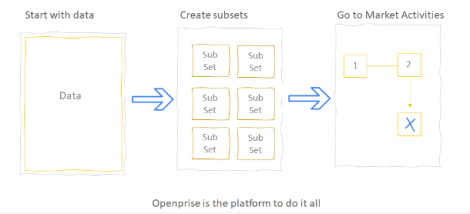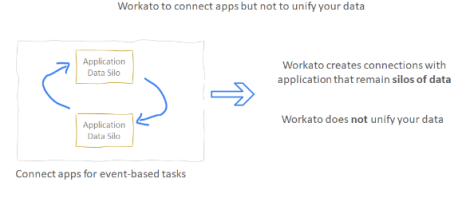
How does Openprise differ from Workato?
Your enterprise applications want to connect with other applications. And once they start connecting, they can’t stop. The pull towards connectivity and integration has been great for the enterprise, and we at Openprise are meeting the demand with no-code solutions that do it all. Now you have the ability to connect any applications to automate the most routine processes in just hours.
Take, for example, common tasks like onboarding new hires. There’s no need to have a system admin grant new hires specific permissions to your HCM or payroll applications. You should automate an everyday, event-based task such as user provisioning through application integrations. But why stop there? Once the connectors are in place, imagine building even more automation—like granting employees access to the apps they need—and then automating all the event-based recruiting tasks. Once you get started, there’s no stopping.
Thanks to general automation platforms like Workato, enterprises have access to a large suite of pre-built, event-based processes to create integrations that might not otherwise exist today so HR can have continually improved, automated processes to boost efficiencies and productivity.
Workato’s wide application
Given that Workato is a general-purpose automation platform, the use cases you can automate go well beyond HR. Workato has done a great job in extending its suite of connectors to the kinds of problems marketing and sales teams experience every day. These can range from event-based activities such as lead routing to sending alerts to sales about changes to a lead to anywhere team members prefer to be notified.
If you work in marketing or sales, you’re probably used to context-switching between applications. So you might have a deep emotional response when you read about the suite of pre-built connectors and use cases that you can automate using Workato. It’s as if Workato can solve all of the problems that stem from “starving” applications that haven’t had the chance to connect with other applications.
Workato’s automation uses are so extensive that practitioners and executives looking for solutions to problems at the top of their funnel—like lead routing, scoring, and routing—could mistake Workato for an all-in-one platform to solve it all. It’s certainly tempting. But, at Openprise, we know that these top-of-funnel problems are inherently complex data management that goes far beyond simple record insertion and update operations. Trying to solve problems rooted in how large sets of data are segmented, grouped, compared, and scored with a soup of connectors will lead you back to where you started in your journey.
More than simply connecting apps
Openprise was purpose-built with an unshakable belief that problems at different points in the funnel are data first. The platform isn’t for general purpose, but for data-intensive, complex processes that can replace point solutions and connectors in the enterprise architecture diagram.
We know that if you want to build go-to-market capabilities like lead management, you must create meaning. The first step toward meaning is to unify data living in application silos. You can only build highly differentiated capabilities once you’ve taken an application-agnostic, holistic approach to data.
After you’ve unified the data, you can segment, compare, and score it to create meaningful subsets. You’re ready to build these highly differentiated go-to-market activities and processes when you have these subsets. And here, Openprise stands out. Using Openprise to unify and create subsets of your data helps the enterprise differentiate itself in the marketplace. In other words, it makes your data work better.

Openprise ingests and stores your data from all your go-to-market applications so you can do just about anything with it. It’s not a simple pass-through for creating and editing data. It’s for more than just basic, event-based processes. It’s built to accommodate simple processes you may already handle, all the way to the most data-intensive and complex orchestration you can dream up—well beyond what Workato is capable of delivering.
Dream up new stuff: Openprise is your sandbox
Since Openprise ingests and stores application data, you can analyze and model processes in a sandbox-like environment without committing to production systems. Imagine being able to perform “what-if” scenarios on your most valuable asset—your data. Create “Aha!” moments using Openprise every day. You can’t do that with Workato.
A place for both Openprise and Workato
We aim to shed some light on Workato’s automation capabilities versus which activities you should solve with Openprise. Any enterprise would do well by using Workato’s suite of no-code connectors to automate routine, event-based tasks. But when you have highly differentiated go-to-market activities, approach them with a data-first attitude. “Data-first” extends well beyond Workato’s capabilities—and right into our sweet spot.
Recommended resources















